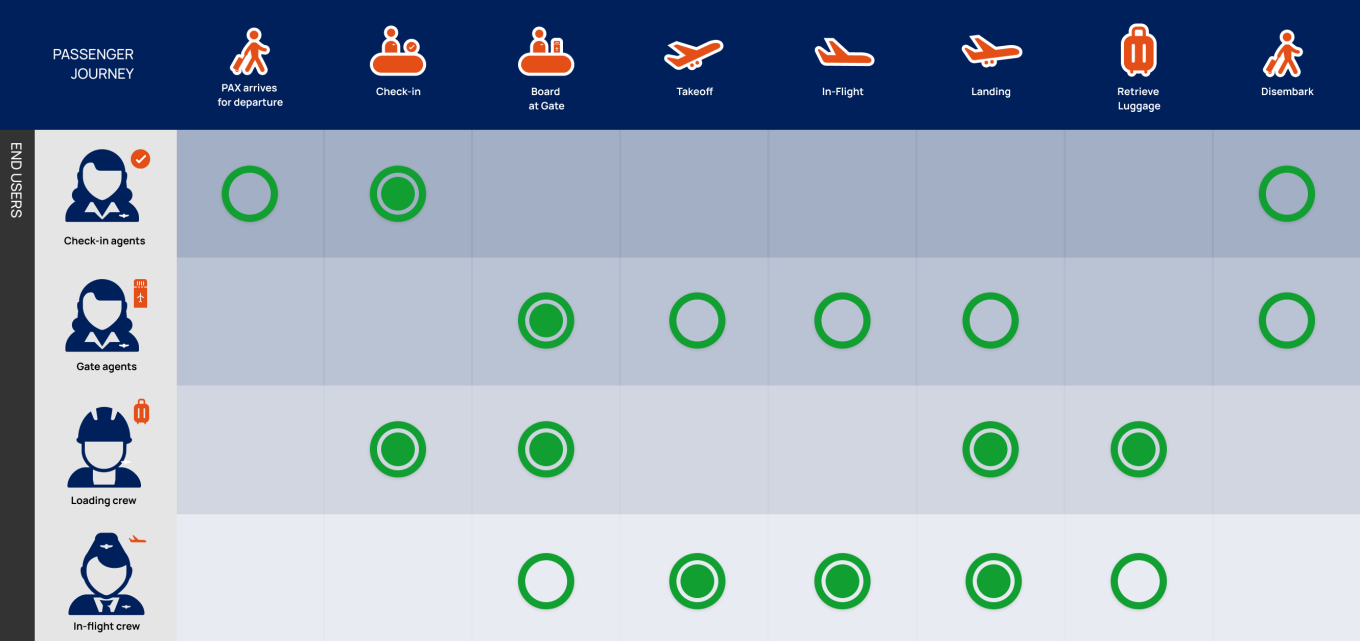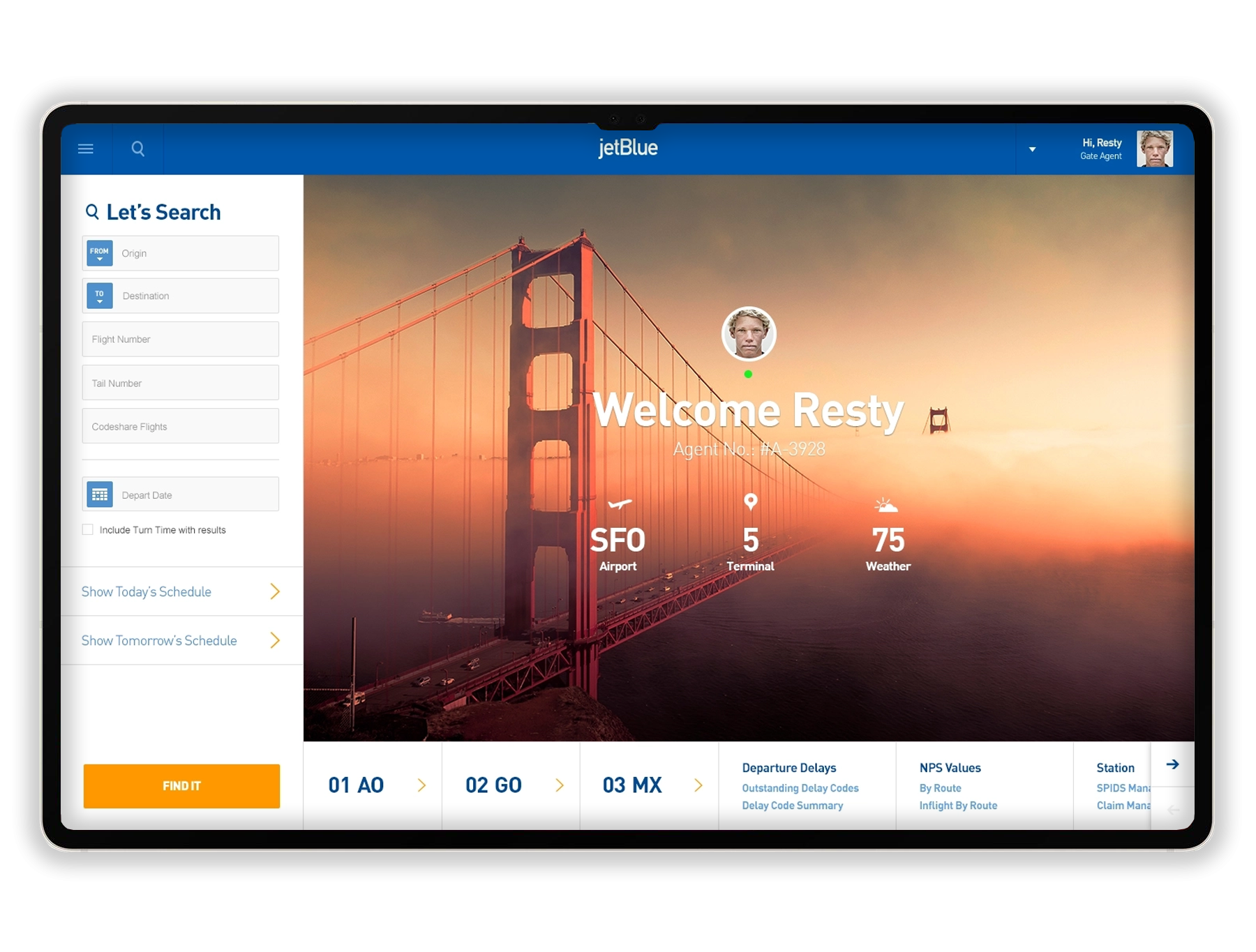JetBlue BlueEye
Integrating with JetBlue’s product team to unlock “You Above All Else” for airport and flight crews
Since 2010, JetBlue’s customer promise has been “You Above All Else”, grounding the carrier’s primary goal to provide a superior travel experience for you, their passenger.
Since its 2000 launch, JetBlue utilized a collection of apps to help deliver that promise. After years of rapid growth, the airline was ready to transition to a modern operational platform that streamlined ground-to-air operations and standardized performance data.
Leading a small and agile agency team integrated at JetBlue’s Long Island City HQ, I helped guide the JetBlue product team to successfully unify their suite of apps into one universal operations platform, BlueEye.
Deliveries
- Business Requirements
- User Journeys
- Platform Integration
-
Product Experience (Mobile/Tablet App, Desktop App, Web experience)
JetBlue
SAAS
Operations Platform
Enterprise Platform
0 -1 Product
Experience Design Director
6 months: 2017 – 2018
BlueEye facilitates JetBlue Crew Member Collaboration
JetBlue serves over 110,000 passengers per day across 1,000+ flights and 110 airports, globally. They have more than 22,000 crewmembers working across their airports and routes, ensuring that every traveler (and their belongings) reaches their destination as smoothly as possible.
These are both visible and invisible roles, operating in airport and in the air. As part of our discovery, we needed to understand every crew member type; their roles, tasks and needs; and, how they collaborate with each other to deliver smooth, on-time performance and best-in-class customer service.
Our end-users, the crewmembers:

Front of House
Pre-security teams at or around the front counter

Gate Agents
Boarding gate teams responsible for assisting

Loading Crews
Behind-the-scenes at the airport, handling and loading checked luggage and food/drink

In-Flight Crews
Flight attendants responsible for the in-flight experience and safety

Diagram displaying our 4 primary crew members (end users) and their major ![]() and minor
and minor ![]() roles across a passenger’s journey.
roles across a passenger’s journey.
As a platform, BlueEye needed to enable each crewmember to swiftly conduct their duties, essentially a be-all, end-all platform.
Duties across roles included:

Front-of-House
Checking-in passengers, verifying documents. confirming assistive equipment or services

Front-of-House
Bag check-in

Front-of-House
Conducting payments

Loading Crew
Tracking bags, ensuring no losses from destination to arrival

Loading Crew
Coordinating crew & vehicles transporting baggage from plane to carousel

Loading Crew
Coordinating with TSA screenings for checked-baggage

Boarding Gate Crew
Tracking in-flight crew locations, verifying staffing for scheduled flights

Boarding Gate Crew
Efficiently addressing the full range of customer requests at the gate

Boarding Gate Crew
Maintaining and reporting on-time boarding and departure of each flight

In-flight crew
Managing and verifying flight manifests for crew and passengers

In-flight crew
Addressing passenger service requests and needs while in air

In-flight crew
Administrating onboard services such as in-flight entertainment and wi-fi
In addition to facilitating crew tasks, BlueEye needed to give crews the ability to communicate with each other, with corporate, and with customers:

BlueEye Comms
Pass messages and announcements to terminal and gate displays

BlueEye Comms
In case of emergencies in-terminal, provide safety and evacuation instructions

BlueEye Comms
Communicate with crew in-transit to ensure flights are fully staffed for on-time performance

BlueEye Comms
Document customer complaints for customer relations to manage (e.g. compensation)

BlueEye Comms
Deliver alerts between crewmember types to address situations as they arise
Setting the functional architecture
Part of discovery occurred on-site at JFK, shadowing grounds crew and observing their tasks. One of the coolest things (and stressful, by proximity) I got to do was go up to the control tower.
We got a chance to see the suite of apps crew used to conduct operations. Switching between up to ten, yes ten, different platforms to achieve complete awareness to get a plane emptied (on arrival), fully boarded, loaded and out of the gate — a process called turnover.
Because of turnover, the majority of tasks on-the-ground was governed by the flight that any given crew member was working — regardless of check-in, gate operations or loading crews; in-flight crews also follow this model as providing service to the flight itself is their core task.
The overall application architecture for BlueEye
BlueEye’s application framework closely mirrored the crew’s needs, with the majority of operations centering around flight ops with the goal of achieving on-time performance.
Digging into the UX
Crew members needed an on-screen experience that would allow them to task focus. Tasks associated with managing flights, however, come with a great deal of information to consume, associate together, adjust and verify.
Most any crewmember’s immediate tasks are associated with the flight they are working at any given time and the app needed to maintain this contextualization at all times, and so flight information (and any primary contextualization in-app) is persistently displayed in the left column.
The majority of operation within that context is then kept to the tabbed right column, which would host BlueEye modules that together provide a holistic informational and task management view for end-users.
A selection of wireframes from the project:
Outcomes
-
74%
Adoption RateAdoption rate by team members within the first 3-months of launch (with the legacy platform continuing to operate concurrently with BlueEye for a grace period of 6 months)
-
–28 sec
Time ReductionAverage measured reduction in times-to-complete for the 5 most common actions by check-in and gate crew, including traveler confirmation, crew tracking (flight-to-flight), bag tracking and re-bookings.
Director’s Note
Maintaining agility through a showstopper
My team was contracted to deliver 4 complete sprints over the course of 6 months working directly with JetBlue’s product team, on-site. We were an agile team of 3 — director, designer, producer — directly integrated into the client’s team.
JetBlue was responsible for casting our team’s business analysts (to define business requirements, or, BRs) as well as the dev/IT team.
We successfully delivered and approved our first sprint in 6 weeks — on-time — when we were handed our BRs for the second sprint, a 3 page powerpoint, with next to no details.
(Sprint 1’s BRs consisted of a 43 page powerpoint deck listing every minute requirement that we needed to solution for.)
Initial BlueEye Team
Integrated Rokkan and JetBlue Talent
- Product Owner (JB)
- 2x Business Analysts (JB)
- UX Director / Lead (RKN, Me)
- UI / Product Designer (RKN)
- Producer (RKN)
- Dev / IT Team (JB)
How we solved
Our business analysts had failed to deliver adequate requirements; we had almost nothing to design for causing a hard stop.
Taking a short-period, we worked with JetBlue to identify what we needed for this project to get back on track, and quickly focused and solved:
- Rokkan adds a agency-side business analyst to the team
- Reduce total sprints from 4 to 3
- The remaining 2 sprints would address in-flight crews and loading crew BlueEye features
- A “Core Product Team” would consist of JB’s product owner, our BA trio and myself, the UX/design lead
- The core product team would hold business requirement discovery and definition workshops prior to each sprint (w/ JetBlue IT and relevant crewmembers, end-users)
- Complete business requirements for the remaining sprints would be written and validated by IT prior to UX for that sprint
New Team Member
Beefing up our discovery
- Rokkan Business Analyst
Deltas
Impacting our previously mapped processes.
- Remaining two sprints would be focused on user type (in-flight, baggage)
- Requirements discovery workshops prior to each sprint
Similar Projects



















